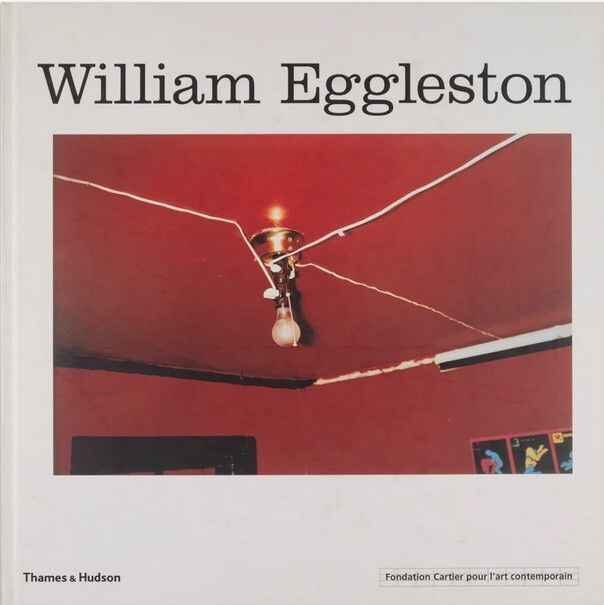
From our archives, written 20 years ago: William Eggleston at the Fondation Cartier pour l’art contemporain Paris. Exhibition from November 20, 2001 until February 24, 2002. Hardcover catalogue by Thames & Hudson (books about William Eggleston at Amazon USA, Amazon UK, Amazon Deutschland, Amazon France).
The photographer William Eggleston was born in 1939 in Memphis, Tennessee, where he still lives. He attended Vanderbilt University, Delta State College and the University of Mississippi. He picked up photography in 1957 and became a freelance photographer in the Mississippi-Tennessee region and in Washington, D.C. He was inspired by Cartier Bresson and Walker Evans, especially in his black and white photos. In 1965, Eggleston began to experiment with color.
In 1967, Eggleston moved to New York City where he was influenced by the work of the street photographers Lee Friedlander and Garry Winogrand. Eggleston showed John Szarkowski, then curator of photography at the Museum of Modern Art in New York, a suitcase full of color slides which led to the landmark exhibition at the MoMA in 1976 and the production of the famous accompanying catalogue William Eggleston’s Guide. The 75 works in color exhibited at the MoMA marked the beginning of the recognition of color photography as an art form. Until then, only black & white photographs were considered as a form of artistic expression whereas color photography was disregarded as a purely commercial medium. The 1976 exhibition traveled to five other American cities. It was a controversial show and the reviews were mixed. Hilton Kramer, the New York Times’ art critic responded to John Szarkowski’s catalogue assertion that Eggleston’s photographs were “perfect”: “Perfect? Perfectly banal, perhaps. Perfectly boring, certainly.”
In a certain sense, Hilton Kramer was right: In order to understand and appreciate Eggleston’s work, art lovers often have to take more than one look at his photographs because he mostly deals with subjects of perfect banality and everyday life, but with artistic care. It is his attention to American normality which makes him special. Only a second look reveals that his photographs are not banal, ordinary color snapshots such as people take them every day. Eggleston is no realist documentary photographer. There is always a touch of poetry in his work. His colors are of an extraordinary beauty and it is surely no accident that Wassily Kandinsky is his favorite painter. Eggleston disregards press photography which, according to him, all resemble each other. For Eggleston, the photograph is a purpose in itself.
In 1974, William Eggleston was a lecturer in Visual and Environmental Studies at Harvard University and in 1978-79 he worked as a researcher in color video at the Massachusetts Institute of Technology.
The appreciation of Eggleston’s work has come a long way since the 1976 exhibtion in NYC. He has been called “father of color photography” – although he did not of course invent it – and since the 1990s he is widely regarded as the leading and most influential color photographer of the 20th century. The rediscovery and worldwide recognition of William Eggleston began in 1992 with an exhibition at the Barbican Gallery in London.
The exhibition at the Fondation Cartier pour l’art contemporain is divided in two parts: a series of photographs of Kyoto produced specifically for the exhibition and the retrospective itself. The catalogue contains 156 retrospective photographs including ten Kyoto photos. Among the 156, one can find the famous tricycle from 1970, seen from the ground, which gives it a gigantic dimension. It is considered his most famous photo. The color quality of the reproductions – essential for Eggleston’s work, especially for the ones executed with the dye transfer process for which he is best known – is remarkable.
In the exhibition catalogue published by Thames & Hudson, William Eggleston did not want an analysis or commentary of his photographs because he prefers art lovers to approach his works without preconceptions. In this context, it comes as no surprise that Eggleston leaves most of his photographs untitled. It is up to the viewer to come up with his individual interpretation.
Exhibition catalogue: William Eggleston. Fondation Cartier pour l’art contemporain Paris, hardcover, 28 x 28 cm, Thames & Hudson, 2002, 168 pages, 156 color and black-and-white reproductions. ISBN: 978-2-74273-560-0.
The book is out of print. Below you can find the red cover of the Thames & Hudson book publisher edition as well as the cover of the Fondation Cartier pour l’art contemporain Paris museum edition.
Books about William Eggleston at Amazon USA, Amazon UK, Amazon Deutschland, Amazon France.
P.S. From January 28 until May 4 2023, you can visit the exhibition William Eggleston: Mystery of the Ordinary at C/O Berlin in the Amerika Haus. Steidl will publish an exhibition catalogue.


Added to our WordPress pages on February 5, 2023 at 22:21 Berlin time. Article originally published on our Microsoft Frontpage pages on February 7, 2002.